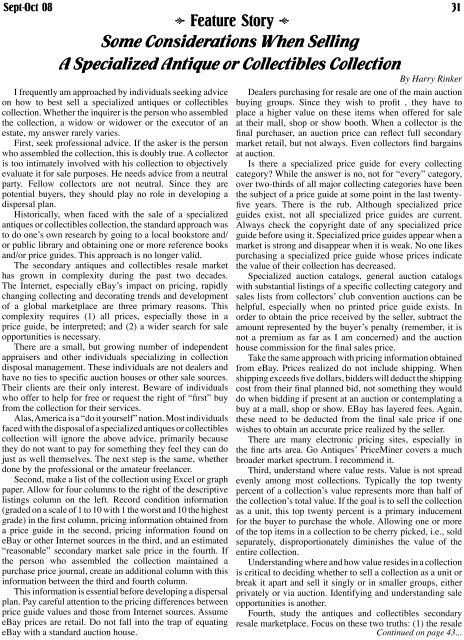The Antique Register™, Inc.
The Antique Register™, Inc.
The Antique Register™, Inc.
Create successful ePaper yourself
Turn your PDF publications into a flip-book with our unique Google optimized e-Paper software.
Sept-Oct 08<br />
� Feature Story �<br />
Some Considerations When Selling<br />
A Specialized <strong>Antique</strong> or Collectibles Collection<br />
I frequently am approached by individuals seeking advice<br />
on how to best sell a specialized antiques or collectibles<br />
collection. Whether the inquirer is the person who assembled<br />
the collection, a widow or widower or the executor of an<br />
estate, my answer rarely varies.<br />
First, seek professional advice. If the asker is the person<br />
who assembled the collection, this is doubly true. A collector<br />
is too intimately involved with his collection to objectively<br />
evaluate it for sale purposes. He needs advice from a neutral<br />
party. Fellow collectors are not neutral. Since they are<br />
potential buyers, they should play no role in developing a<br />
dispersal plan.<br />
Historically, when faced with the sale of a specialized<br />
antiques or collectibles collection, the standard approach was<br />
to do one’s own research by going to a local bookstore and/<br />
or public library and obtaining one or more reference books<br />
and/or price guides. This approach is no longer valid.<br />
<strong>The</strong> secondary antiques and collectibles resale market<br />
has grown in complexity during the past two decades.<br />
<strong>The</strong> Internet, especially eBay’s impact on pricing, rapidly<br />
changing collecting and decorating trends and development<br />
of a global marketplace are three primary reasons. This<br />
complexity requires (1) all prices, especially those in a<br />
price guide, be interpreted; and (2) a wider search for sale<br />
opportunities is necessary.<br />
<strong>The</strong>re are a small, but growing number of independent<br />
appraisers and other individuals specializing in collection<br />
disposal management. <strong>The</strong>se individuals are not dealers and<br />
have no ties to specific auction houses or other sale sources.<br />
<strong>The</strong>ir clients are their only interest. Beware of individuals<br />
who offer to help for free or request the right of “first” buy<br />
from the collection for their services.<br />
Alas, America is a “do it yourself” nation. Most individuals<br />
faced with the disposal of a specialized antiques or collectibles<br />
collection will ignore the above advice, primarily because<br />
they do not want to pay for something they feel they can do<br />
just as well themselves. <strong>The</strong> next step is the same, whether<br />
done by the professional or the amateur freelancer.<br />
Second, make a list of the collection using Excel or graph<br />
paper. Allow for four columns to the right of the descriptive<br />
listings column on the left. Record condition information<br />
(graded on a scale of 1 to 10 with 1 the worst and 10 the highest<br />
grade) in the first column, pricing information obtained from<br />
a price guide in the second, pricing information found on<br />
eBay or other Internet sources in the third, and an estimated<br />
“reasonable” secondary market sale price in the fourth. If<br />
the person who assembled the collection maintained a<br />
purchase price journal, create an additional column with this<br />
information between the third and fourth column.<br />
This information is essential before developing a dispersal<br />
plan. Pay careful attention to the pricing differences between<br />
price guide values and those from Internet sources. Assume<br />
eBay prices are retail. Do not fall into the trap of equating<br />
eBay with a standard auction house.<br />
31<br />
By Harry Rinker<br />
Dealers purchasing for resale are one of the main auction<br />
buying groups. Since they wish to profit , they have to<br />
place a higher value on these items when offered for sale<br />
at their mall, shop or show booth. When a collector is the<br />
final purchaser, an auction price can reflect full secondary<br />
market retail, but not always. Even collectors find bargains<br />
at auction.<br />
Is there a specialized price guide for every collecting<br />
category? While the answer is no, not for “every” category,<br />
over two-thirds of all major collecting categories have been<br />
the subject of a price guide at some point in the last twentyfive<br />
years. <strong>The</strong>re is the rub. Although specialized price<br />
guides exist, not all specialized price guides are current.<br />
Always check the copyright date of any specialized price<br />
guide before using it. Specialized price guides appear when a<br />
market is strong and disappear when it is weak. No one likes<br />
purchasing a specialized price guide whose prices indicate<br />
the value of their collection has decreased.<br />
Specialized auction catalogs, general auction catalogs<br />
with substantial listings of a specific collecting category and<br />
sales lists from collectors’ club convention auctions can be<br />
helpful, especially when no printed price guide exists. In<br />
order to obtain the price received by the seller, subtract the<br />
amount represented by the buyer’s penalty (remember, it is<br />
not a premium as far as I am concerned) and the auction<br />
house commission for the final sales price.<br />
Take the same approach with pricing information obtained<br />
from eBay. Prices realized do not include shipping. When<br />
shipping exceeds five dollars, bidders will deduct the shipping<br />
cost from their final planned bid, not something they would<br />
do when bidding if present at an auction or contemplating a<br />
buy at a mall, shop or show. EBay has layered fees. Again,<br />
these need to be deducted from the final sale price if one<br />
wishes to obtain an accurate price realized by the seller.<br />
<strong>The</strong>re are many electronic pricing sites, especially in<br />
the fine arts area. Go <strong>Antique</strong>s’ PriceMiner covers a much<br />
broader market spectrum. I recommend it.<br />
Third, understand where value rests. Value is not spread<br />
evenly among most collections. Typically the top twenty<br />
percent of a collection’s value represents more than half of<br />
the collection’s total value. If the goal is to sell the collection<br />
as a unit, this top twenty percent is a primary inducement<br />
for the buyer to purchase the whole. Allowing one or more<br />
of the top items in a collection to be cherry picked, i.e., sold<br />
separately, disproportionately diminishes the value of the<br />
entire collection.<br />
Understanding where and how value resides in a collection<br />
is critical to deciding whether to sell a collection as a unit or<br />
break it apart and sell it singly or in smaller groups, either<br />
privately or via auction. Identifying and understanding sale<br />
opportunities is another.<br />
Fourth, study the antiques and collectibles secondary<br />
resale marketplace. Focus on these two truths: (1) the resale<br />
Continued on page 43...



